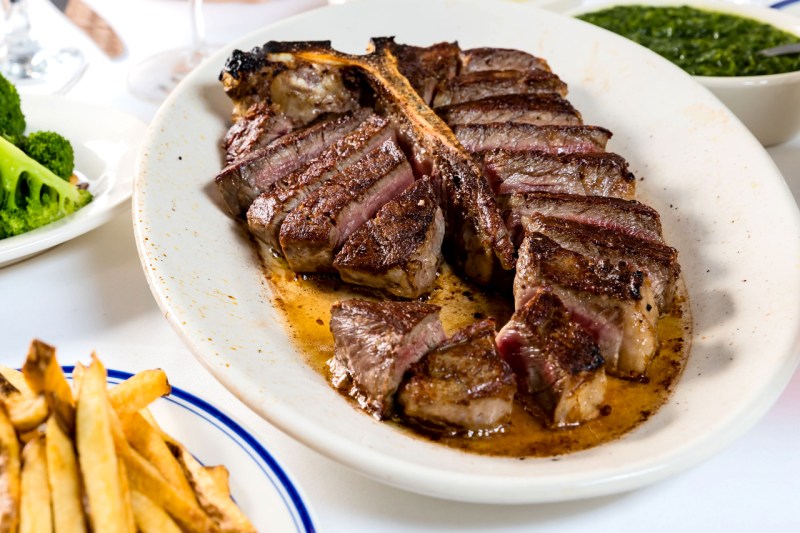
Whether cooking a special dinner at home or enjoying an indulgent meal at a restaurant, nothing says celebration like steak and red wine. Rich and full-bodied, this food and drink combination is truly one of the best pairings in the culinary world. It’s also a complicated topic, one which encompasses many options and flavor profiles. To guide our readers through this intricate culinary space, The Manual has sought out a steakhouse professional. Besides being experts on all things beef, most high-end steakhouses also employ wine masters, with most establishments featuring an in-house sommelier whose sole job is to explain the restaurant’s wine list for customers; making wine pairing suggestions based on each customer’s preferences.
Opened in December 2017, Tuscany Steakhouse in New York is owned by veteran restaurateur Steve Haxhiaj, an alumnus of Wolfgang’s Steakhouse and previous owner of Il Monello, an Italian restaurant on the Upper East Side that operated from 2001 to 2008. What makes Tuscany Steakhouse unique is its blend of Italian American and classic American steakhouse flavors, making Haxhiaj the perfect expert to guide anyone through a steak and wine pairing.
Why Red Wine and Beef?

The key to a great steak and wine pairing is balancing flavors. The natural tannins in red wine aid in cutting through the natural richness and fat of a steak, mellowing even very dry wine. Red wine also has natural bitter notes. A good steak pairing will not negate this. Instead, when properly paired, the combination should increase the flavors and aroma of both items, ensuring a perfect synergy.
“It is completely up to the preference of the person enjoying the steak, however great red wine pairs well with red meat because it gives you just enough of an acidic tang that is full-bodied, which is needed to balance out the bold and heavy flavors of the steak,” said Haxhiaj.
Besides beef, wine is also great with other red meats like lamb, pork, and veal. Prime, high-quality beef will be stronger in taste than these three animal proteins, making the wine pairings different. For these meats, Haxhiaj recommends the David Bruce – Russian River Valley, the Barbaresco – Pio Cesare, and a Ruffino Chianti.
How to Pair Steak and Wine

The first step to a great steak and wine pairing is to source the best products you can afford. Whenever possible, try to use USDA prime beef with good marbling along with a great bottle of wine. A great steak also doesn’t need complicated marinades or seasonings. A generous coating of salt and pepper is more than enough.
Steak cuts can also vary from lean to well-marbled, with flavors ranging from mellow to rich. Because of this variety, different cuts pair with different red wines.
Ribeye
The ribeye, a favorite among steak lovers, is well-marbled, tender, and not lacking in rich beefiness. The best choice of wine for this dynamic steak will be full-bodied with lots of tannins. A wine with a high tannin level will help cut through the richness of the ribeye. Zinfandel is a good choice as this wine’s inherent fruit-forward flavor is a great complement. But the most iconic choice is a Cabernet Sauvignon. Haxhiaj recommends either a California Duckhorn Cabernet, Cakebread Cabernet, or Faust Cabernet for ribeye.
Filet Mignon
While the filet is extremely tender, it doesn’t pack the same level of beefiness or fat as other cuts (ribeye for example). Because of its relatively mellow flavor, the wine pairing for filet should be subtle and not rich in tannins. A strong wine like a Cabernet can overwhelm the natural flavor of a filet. For this elegant steak, Haxhiaj recommends Pinot Noirs like David Bruce or Belle Gloss.
Porterhouse/T-bone
Finally, the porterhouse, the most iconic of steakhouse cuts. Centered by a t-shaped bone, the porterhouse is actually two steaks in one — the strip loin and filet. A T-bone is the same as a porterhouse, only with a smaller portion of the filet. Since the porterhouse has two cuts, wine pairings for this cut are very versatile. Both the strip and filet are leaner cuts in comparison to the ribeye (the strip will have a richer taste than the filet). For the best wine pairing, try a Pinot Noir or even a Cabernet.
Pairing for Dry-Aged and Wet-Aged Steaks
Most steakhouses will age their meat either by wet-aging or dry-aging. Wet-aging is the process of taking a whole portion of beef (a whole strip loin, for example, that is not yet cut into individual steaks) and placing it in a vacuum-sealed plastic bag in a cold room for at least ten days. As the beef sits, the natural enzymes of the meat will break down and help tenderize the meat. Dry-aging is taking the same portion of beef (sans plastic bag) and letting it sit in a temperature and humidity-controlled room for four to six weeks (although many steakhouses will age longer). The finished dry-aged beef will shrink in weight and have a layer of mold on the exterior.
Wet-aged beef will be tender but will not have the intense beefiness of dry-aged meat. Because of these changes to the meat, the wine pairing also changes. “For the dry-aged meats,” said Haxhiaj. “I always recommend a full-body red wine (unless if a customer has a special preference) like a Californian Cabernet or the Caymus Special Selection. The Nickel & Nickel “Sullinger” from Napa Valley is also a great choice. And for fresh, wet-aged meat, we always recommend a medium body red wine like a Chianti or a Barolo.”



